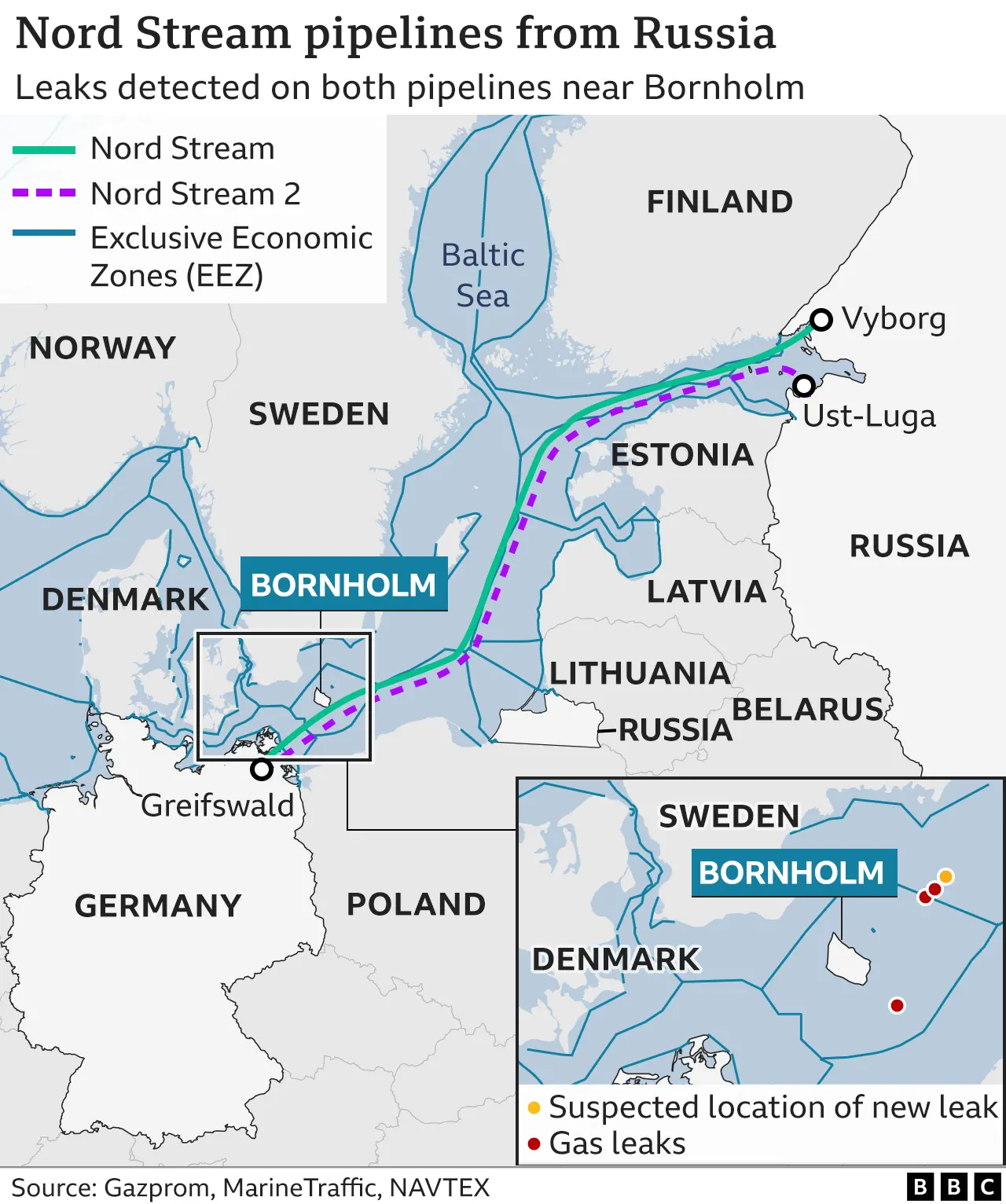Nord Stream: Sweden finds new leak in Russian gas pipeline
Sweden has found a new leak in a major undersea pipeline carrying Russian natural gas to the EU - making it the fourth discovered this week.
Denmark and Sweden reported gas leaks in the Nord Stream 1 and 2 pipelines earlier this week.
Nato said the incidents were the result of "deliberate, reckless and irresponsible acts of sabotage".
Russia dismissed suggestions that it had attacked its own pipelines as "predictable and stupid".
Instead, the Russian foreign ministry said the blasts had occurred in "zones controlled by American intelligence".
The German ambassador to the UK, Miguel Berger, told the BBC it was clear that a non-state actor could not have been behind the incidents - in other words, a country must have been responsible.
The Swedish coast guard said they had found the fourth leak on Nord Stream 2, very close to a larger leak found earlier on Nord Stream 1.
The EU has repeatedly accused Russia of using gas supplies as a weapon against the West, in retaliation for its support for Ukraine.
It is "very obvious" who is behind the damage, said the head of the International Energy Agency, Fatih Birol, without elaborating.
Kremlin spokesperson Dmitry Peskov said he was "extremely concerned" about the leaks, adding that the possibility of a deliberate attack could not be ruled out.
EU leaders have said any attack on the continent's energy infrastructure would be met with the "strongest possible response".
Meanwhile, Norway - which is not in the EU - said it would deploy its military to protect oil and gas installations.
Neither Nord Stream 1 or 2 is transporting gas at the moment, although they both contain gas.
The Nord Stream 1 pipeline - which consists of two parallel branches - has not transported any gas since late August when Russia closed it down, saying it needed maintenance.
It stretches 1,200km (745 miles) under the Baltic Sea from the Russian coast near St Petersburg to north-eastern Germany. Its twin pipeline, Nord Stream 2, was halted after Russia invaded Ukraine in February.
Seismologists reported underwater blasts before the leaks emerged. Denmark's Defence Command has released footage of the leaks which shows bubbles - the largest is 1km in diameter - at the surface of the Baltic Sea.
And Bjorn Lund of Sweden's National Seismology Centre said there was "no doubt that these were explosions".
However, Andrei Kortunov of the Russian International Affairs Council - a Moscow-based think tank - said a Russian attack didn't make sense.
"They always point finger at Russia but I think since it's the Russian property it would be not very logical for Russia to inflict damage upon it," he told BBC Radio 4.
"There are other ways to make European lives harder. They can simply stop the gas deliveries without damaging the infrastructure."

What does this mean for the environment?
By Jonah Fisher, BBC climate correspondent
The bad news is that methane - the gas in the Nord Stream pipelines - has a powerful warming effect on our climate.
During the first 20 years after its release, methane is about 80 times more powerful than CO2 - the most common greenhouse gas - at trapping heat in the Earth's atmosphere.
At this point nobody is sure how much has leaked out.
The good news - if one can talk in those terms - is that in the context of global emissions, the quantity bubbling into the Baltic Sea is likely to be small.
One American scientist estimates that the climate impact of the methane in the pipe could be equivalent to about 2.5 hours of global CO2 emissions. A Danish energy official said the leak could amount to about a third of Denmark's yearly CO2 emissions.
Methane only lasts a decade or so in our atmosphere (compared to hundreds of years for CO2), which is why cutting emissions from the fossil fuel industry is seen as one of the quickest ways of slowing global temperature rises.


